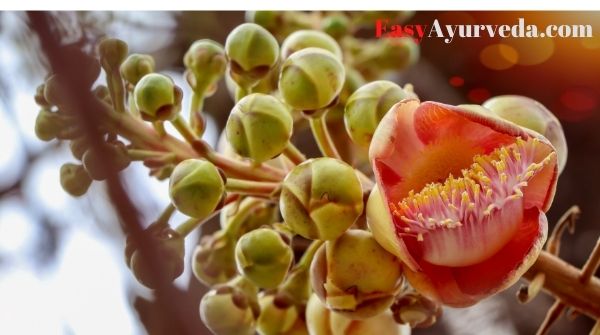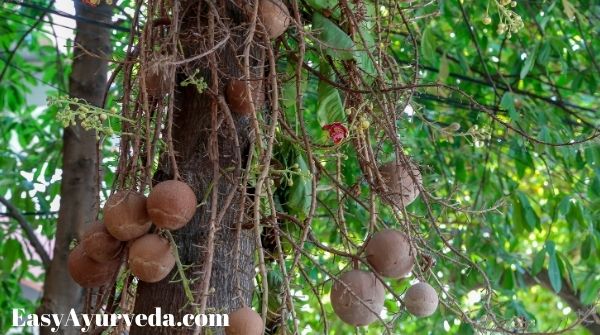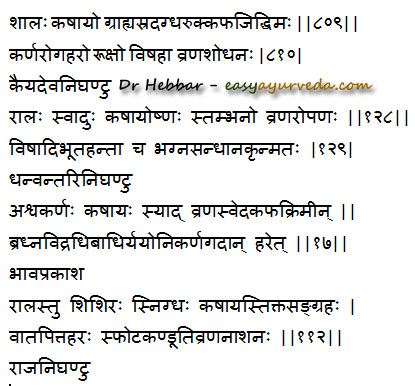Sal Tree – Shorea robusta – Ayurveda Details And Health Benefits
Sal Tree is known as Shala in Ayurveda. It is mainly used in treating non healing wounds, diabetes, boils, deafness etc. Its resin, bark, sap wood, oil etc are used for various therapeutic purposes.
Botanical name : Shorea robusta
Family : Dipterocarpaceae (shala kula)

Table of Contents
Vernacular names, Sanskrit synonyms
English name: Sal tree, Common Sal, Indian Dammer, Canonball tree
Hindi name: Sakher, Sakhu, Sal, Shal
Bengali name – Skaher, Skahua, Sal
Gujarati name – Ral
Marathi name – Rala, Sajara
Oriya name – Sagua, Salo, Sarjjo
Punjabi name – Sal, Seral
Tamil name – Attam, Kungiliyam, Shalam, Talur
Telugu name – Gugilamu, Sarjamu
Russian – Sal, Salovoe Derevo, Shoreia Moshchnaia
Urdu – Raal
German – Salbaum, Salharzbaum
Nepali – Agrakh, sakhua, sakwa, sal
French – Damar de l’Inde, Arbre à Sal, Balau Jaune
Assamese – Sal
Chinese – Suo Luo Shuang, Suo Luo Shuang Shu
Japanese – Sara Noki, Serangan Batsuu, Shara Noki
Oriya – Sagua, Sal, Salwa, Sekwa
Sanskrit Synonyms
Ashwakarna – Leaves of Sala resembling with ears of horse
Dhupavriksha – Gum resin is used for fumigation purpose
Rala- Fumigation with its resin bring pleasantness
Kanakalodhbava, kalyana, Kanta, Rala Niryasa, Vrischikara, Shalaniryasa, Sarjaniryasa, surabhi, Sarjarasa.
Maricha Patraka – leaves resemble those of black pepper.
Sura dhoopa, Yakshadhoopa – the resin is used as an incense stick, with good fragrance.
Agnivallabha – resin catches fire easily
Classical categorization
Charaka samhita – Vedanasthapana (pain relieving), Kashaya skanda (astringent group of herbs)
Sushruta Samhita – Salasaradi Gana, Rodhradi Gana
Bhavaprakasha Nighantu – Vatadi Varga
Ashtanga Sangraha – Asanadi, Rodhradi, Vedanasthapana
Ashtanga Krudaya – Asanadi Gana, Rodhradi Gana
Raja Nighantu, Dhanwantari Nighantu Chandanadi Varga
Kaiyyadeva Nigahtnu – Oshadhi Varga
Morphology
Shorea robusta is a large deciduous tree. Bark is thick, rough with deep vertical furrows and brown in color. Leaves are simple, shiny, leathery, reddish in color when young and then turn green. They are arranged alternately, oval in shape and tapers at the tip. Flowers are arranged in a unilateral panicle, petals are yellowish white, hairy outside, orange inside. Fruits are large, oval in shape, hairy when young and brown in color. Seeds are oval in shape.
Distribution
Shorea robusta is found in India, Nepal and Bhutan.

Controversy and varieties
Shala – Shorea robusta
Sarja – Copal tree resin – Vateria indica
Ashwakarna – Dipterocarpus alatus
Ajakarna – Shorea tumbuggaia
All the above yield resins. Overall, Shala , Rala and Shala niryasa refers to resin obtained from Shorea robusta and Sarja, Sarjarasa, Sarja Niryasa refers to – Copal tree resin – Vateria indica
Chemical constituents
Shorea robusta contain ursolic acid , α-amyrenone, α & β-amyrin27,28; bark contains ursonic acid, oleanane, Shoreaphenol; seed contains hopeaphenol, leucoanthocyanidin, and 3,7-dihydroxy-8-methoxyflavone7-O-α-l-rhamnopyranosyl-(1→4)-α-l-rhamnonopyrano- syl(1→6)-β-d-glucopyranoside31; while heartwood contains germacrene-D24.
Trunk of Shorea robusta when incised exudes oleo gum resin.
Sal bark is used for tanning. Resin is composed of chemicals like hydroxyanone, dammarenediol II, Ursolic acid etc.
Part used, Dose
Part used: Bark, sap wood, heartwood, resin, oil, seeds, seed oil
Dose: Bark decoction – 50 – 100 ml, Rala (resin) – 1- 3 grams, in divided dose per day.
Medicinal properties
Taste: Kashaya (astringent), madhura (sweet)
Guna (qualities) – Rooksha (dryness), Ushna (hot)
Vipaka – taste conversion after digestion – pungent
Veerya – Sheeta – Cold potency
Pharmacological action – Astringent, Cooling, Aromatic, Anti microbial, Expectorant, Carminative
Sanskrit Verses

Sal tree benefits
Rala – the resin of Shala herb is sweet, astringent, hot in nature, has antimicrobial properties,
Bhagnasandhanakrut – useful in fracture healing
Asra-dagdharuk – relieves pain due to wounds and burns.
Vishaha – anti-toxic,
Vranashodhana – cleanses wounds and quickens wound healing
Grahi – absorbent, useful in diarrhea, IBS
Karnarogahara – useful in ear disorders
Svedahara – decreases excessive sweating
Badhiryahara – useful in treating deafness
Sphotahara – useful in boils
Kandunashana – relieves itching, pruritus
External application:
Rala – the resin of sal tree is applied externally in the form of paste to treat painful swellings.
Because of its wound cleansing and healing properties, it is used as an ingredient in herbal ointment such as Shweta malaham
Pharmacological Activity
Sal possesses anti-inflammatory, anti-obesity, antibacterial, wound healing, antipyretic and analgesic activities.
Research
Phytochemical analysis – A study of ‘Comparative phytochemical analysis of Shorea robusta Gaertn (oleoresin) WSR to its seasonal collection’ have revealed that the oleoresin collected in Spring season contained more tannin, resin, volatile matter, phenolic content as compared to the oleoresin collected in Winter season (Hemantha rutu) .
Wound healing activity – A research study conducted to evaluate wound healing activity have proved significant wound healing activity of ethanolic extract of Shorea robusta resin.
Side effects
There are no known side effects.
It is used in children and lactating mothers. Seek medical advice for use during pregnancy.
Interaction with medicines, supplements
Can this be used while taking Homeopathic medicine?
Yes. This product does not react with homeopathic medicine.
Can this medicine be continued while taking supplements like multivitamin tablets, Omega 3 fatty acids etc?
Yes. Generally, this product goes well with most dietary supplements. However, if you are taking more than one product per day, please consult your doctor for an opinion.
With western
medicines
Seek your
doctor’s advice if you are taking this product along with other western
(allopathic / modern) medicines. Some Ayurvedic herbs can interact with modern
medicine.
If both Ayurvedic and allopathic medicines are advised together, then it is
best to take Allopathic medicine first, wait for 30 minutes and then take the
Ayurvedic medicine.
Ayurvedic medicines
Ayurvedic medicines with Sal tree ingredient:
Asanadi Kashayam -used in the treatment of diabetes, skin diseases and obesity etc
Eladi Thaila – used in skin diseases
Ayaskriti – used in anemia, vitiligo
Chandanadi Vati tablet – used in treatment of diabetes and urinary tract disorders
Somanath Ras – used in the treatment of frequent urinary complaints, menorrhagia, leucorrhea.
Scientific classification
Kingdom – Plantae
Order – Malvales
Family – Dipterocarpaceae
Genus – Shorea
Species – S. robusta
Sthanika Karma (Systemic Action)
External Application – It has Analgesic, Anti microbial, wound healing and cleansing effects. Promote fracture healing . paste can be applied on skin diseases like dadru, boils, cracked foot and burns. bark and resin can be used in painful inflammatory conditions. It can be used for fumigation. In ear infection its bark decoction is indicated for external use.Internal administration-
Nervous system – It has analgesic action. decoction can be taken to reduce body pain due to fall, injury etc.
Digestive system – Absorbent. indicated diarrhea, rectal bleeding, Hemorrhoids etc.
Circulatory System – Indicated in Bleeding disorders, and anemia caused due to excessive blood loss.
Respiratory system – Bark pacifies kapha dosha, latex helps to expel out vitiated kapha dosha from the respiratory tract.
Reproductive system – Indicated in Leukorrhea, Menorrhagia, Metrorrhagia etc. Indicated in inflammatory conditions associated with the uterus and associated structures.
Excretory system – Reduces urine output, hence indicated in diabetes. Resin is indicated in UTI as it possesses Antimicrobial property.
Satmikarana – Indicated in fractures and wounds. Also beneficial in obesity and associated conditions.









5 comments on “Sal Tree – Shorea robusta – Ayurveda Details And Health Benefits”
v.k.dixit
Very useful details.
Dr JV Hebbar
Thanks.
Dr vidya magadum
Very nice information
virupakshgupta
check the authenticity of pics
medhavi sharma
Hello raal is good for stomach ulcer? If not
What is best medicine for stomach ulcer
Please answer it